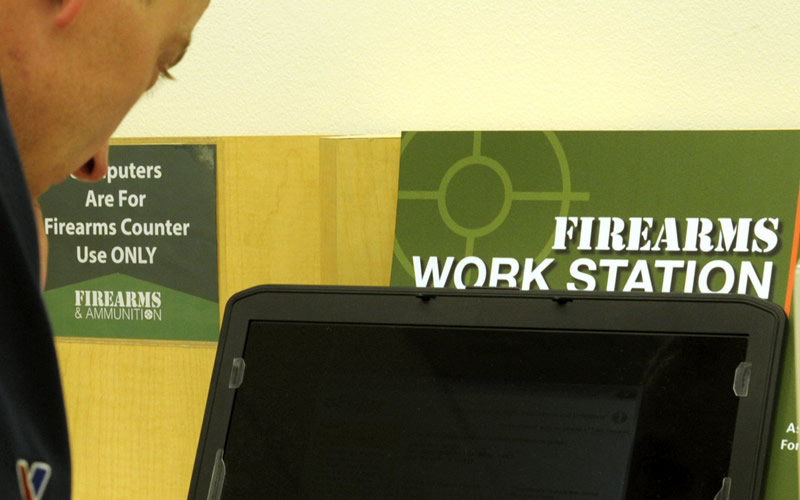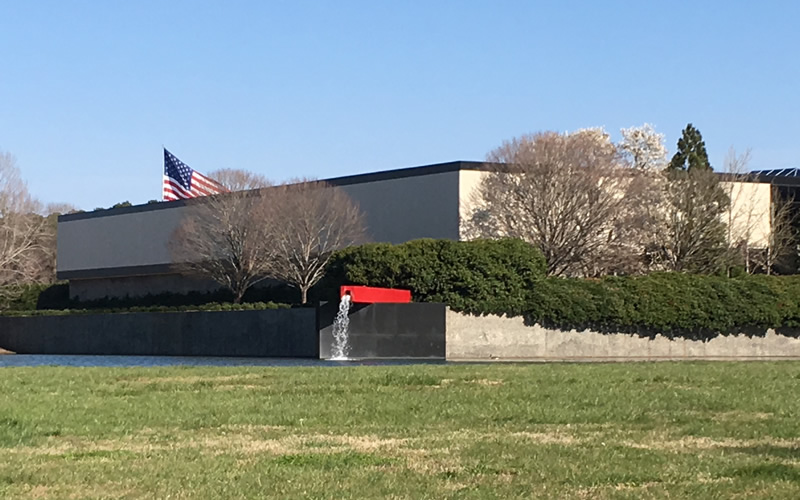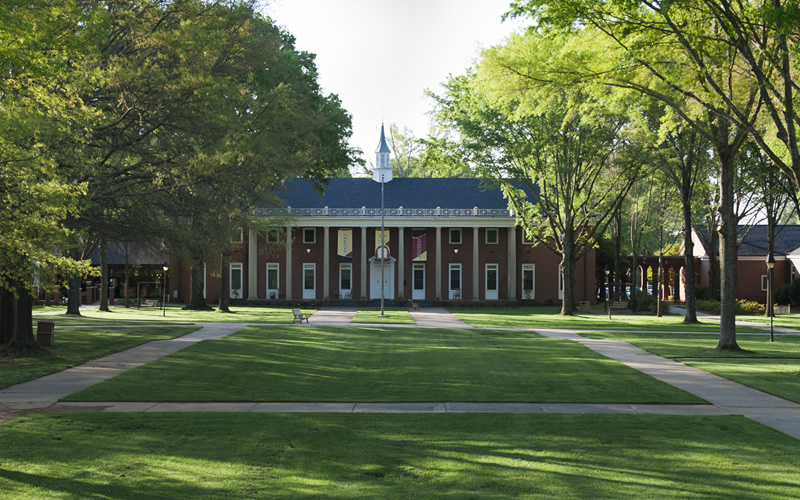NEWS: Narrow gun reform measure inches forward in Senate
BRIEFS: Liquor stores, drilling, medical marijuana, conservation bank
CALENDAR: Gubernatorial candidates to debate in May, June
TOP FIVE: On retirees, solar power, SNAP, Alzheimer’s and gas
COMMENTARY, Brack: Are smartphones, social media making us dumber?
SPOTLIGHT: Conservation Voters of South Carolina
MY TURN, Ulbrich: Restore personal exemption to not penalize S.C. families
FEEDBACK: Send us your thoughts
MYSTERY PHOTO: Red fountain
S.C. ENCYCLOPEDIA: Erskine College
NEWSNEWS: Narrow gun reform measure inches forward in Senate

By Lindsay Street, Statehouse correspondent | Nearly three years after nine black parishioners — including a state senator — were gunned down in a Charleston church by a white supremacist, members of a Senate committee say they are poised to advance the body’s first gun reform related to the 2015 incident.
But it’s not the recent news of the Florida school shooting and subsequent student advocacy that brought the issue into the South Carolina committee this week. Rather, it’s the trudging of legislative process, according to Sen. Marlon Kimpson, the Charleston Democrat who is sponsor of the bipartisan bill.
“It took us this long to get it where it is,” Kimpson told Statehouse Report. In the Judiciary Committee, the bill drew discussion Tuesday but did not get a favorable vote to go to the Senate floor. But committee members on both sides of the aisle say the bill is likely to make it out of committee although it is not currently scheduled to be heard again and Kimpson says work remains. While the bill may make it to the floor, some say it won’t get much further this year — either due to it not being a priority or the fast-approaching end of the session.
Narrowly-tailored reform
Kimpson said his bill isn’t a hard stance on gun reform, and called it the “lightest but still meaningful.” He said it is the most “narrowly tailored” gun reform bill.

“If we can’t get this bill passed it will be impossible to do anything else on gun reform,” Kimpson said. “People are walking in schools and shooting the place up, and we still can’t get anything done.”
A gun-reform nonprofit that was founded after the Emanuel AME Church shooting, Arm-in-Arm, has been closely following the proposal (S. 516), also known as the Charleston loophole bill.
“This piece of legislation has resulted in the best conversations in changing the system,” founder Meghan Alexander told Statehouse Report this week. “That’s crucial. We’re not going to make any headway until we have these conversations over and over again … It’s all productive.”
South Carolina has leaned toward relaxing gun ownership and purchasing rules rather than tightening restrictions, with two recent exceptions. In 2013, after a threatened shooting at a Charleston private school, the state enacted a law that required the reporting of some mental health information to the federal database used for background checks of firearms buyers In 2015 after news stories about South Carolina having the nation’s highest rate of domestic violence, the state also enacted a law that prohibited gun possession by certain domestic abusers.
On closing the loophole
Kimpson’s bill does two things. First, it shortens the amount of time S.C. courts have to report gun-barring offenses to a database from 30 days to five days. Second, it lengthens the delay period for those seeking to buy a gun who aren’t either outright rejected or approved from three days to five days. It’s estimated to impact fewer than 7 percent of purchases. Also, the lengthened delay period would sunset after two years.
The delay period has been the most contentious part of the bill. It seeks to close the “Charleston loophole,” so named for the church gunman’s ability to purchase a gun — despite being charged with drug possession prior to his purchase of the gun that was used in the massacre. Authorities blamed the gunman’s purchase of the firearm on a clerical error.
The narrow focus of the bill has won it support but it has also drawn ire from both sides of the aisle.

“A lot of us feel like it doesn’t resolve any issue whatsoever,” said Sen. Stephen Goldfinch, a Georgetown Republican on the committee. He added he thought the bill would move out of committee to the Senate floor, however. A full meeting of the Judiciary is not scheduled at this time.
Sen. Gerald Malloy, D- Darlington, said his main issue with the bill was that it doesn’t do enough. Malloy chaired the Senate’s gun study committee and said S.C. Sen. Clementa Pinckney, Emanuel AME’s slain pastor, was a friend of his.
“It does nothing,” he said, calling it “feel-good legislation” and “masquerading it to the public as if we’re doing something.”
‘Art of the possible’
Kimpson said the additional two days for the waiting period reflected a compromise to bring the legislation to reality.
“Politics is the art of the possible and the best we could do is two additional days for two years,” he said. He added he hoped the additional two days over two years would help background checkers in the state “catch up” on checks.
“I don’t have a problem with it the way they changed it with that sunset clause,” Shealy said. She added that while it may not have stopped killer Dylann Roof’s rampage, it could catch others with the speedier time frame on reporting. “The biggest problem is mental illness or people with CDV (criminal domestic violence) who don’t get reported in time.”

Malloy said the court reporting aspect of the bill is the strongest and best concept, but said it is flawed due to some municipalities not having the same reporting system.
“I agree to move it forward but I think it has no chance of passing (the full Senate),” Malloy said. “It’s not a priority of the Senate and it’s not a (gun) committee bill.”
Goldfinch said he could see the possibility of it getting a positive vote in the Senate, despite Malloy’s skepticism. Shealy said she wasn’t sure if the Senate would have time to vote on it before the April 10 crossover deadline, after which a two-thirds majority is needed to pass the legislation.
The national conversation
While Kimpson said he doesn’t believe the Feb. 14 deadly high school shooting in Florida and the subsequent student protests spurred gun discussion in committee, Arm-in-Arm’s Alexander sees a connection.
“It’s impossible to ignore what is being said by the students right now and the educators and the parents,” Alexander said. “Parkland forced us all to look at it and say, ‘This could be my family.’
Arm-in-Arm is working to help organize the Charleston March for Our Lives protest Saturday. The group will also hold a discussion 5 p.m. to 7 p.m. March 28 at Daniel Island Library. The event is also organized by Moms Demand Action. Click here for more information.
There are 10 March for Our Lives events scheduled for Saturday around South Carolina. Click here to see where protests are scheduled.
Other bills related to guns
Here is a list of some other gun-related bills. There have been more than 50 so far this session, including some filed last week by S. 516’s Republican co-sponsor Greg Gregory.
- A bill banning bump stocks, raising the age to 21 to purchase a rifle, and the prohibition of large-capacity magazine ( 1118; similar to H. 3183 and H. 4975)
- Expanded/universal background checks (H. 3181)
- Background check delay period (S. 159)
- Making it unlawful to sell handguns to underage persons, with exemptions (S. 527)
- Prosecuting breaches such as falsification (S. 430)
- Unlawful threats with a firearm (S. 431)
There has also been a spate of school anti-violence bills considered following the Florida massacre, including one criminalizing school threats by Sen. Sandy Senn, R-Charleston. More: S. 431, which is similar to H. 5007.
- Have a comment? Send to: feedback@statehousereport.com.
BRIEFS: Liquor stores, drilling, medical marijuana, conservation bank
![]() By Lindsay Street, Statehouse correspondent | The S.C. Senate was consumed by questions over liquor store licenses this week as it grappled to comply with a S.C. Supreme Court order that found the state’s three-store limit to be unconstitutional.
By Lindsay Street, Statehouse correspondent | The S.C. Senate was consumed by questions over liquor store licenses this week as it grappled to comply with a S.C. Supreme Court order that found the state’s three-store limit to be unconstitutional.
After debating the special-order item for nine hours Wednesday, the Senate agreed to set limits depending on population size. If a county’s population is under 250,000 people, then the three-store limit remains. Read more here.
Here is a list of other issues that happened this week:
Banning the plastics bag ban. The Senate debated a bill this week that would ban municipalities from enacting bans on plastic bags. The House has already passed the bill. Read this op-ed for more information on the ban.
Drilling report released. After months of studying the offshore drilling issue, the House’s Agriculture, Natural Resources and Environmental Affairs Committee’s ad hoc committee released its report. The report takes no official stance on the two warring bills that are seeking to encourage or discourage offshore drilling in the state. Read the report here.
Lottery scholarship changes loom. One thing is certain: the way the S.C. Education Lottery currently doles out scholarships is likely to change to avoid demand outstripping supply. This week, lawmakers proposed making tougher requirements by raising the GPA and standardized testing eligibility. Another lawmaker is seeking to allow the state-funded scholarships to apply to out-of-state schools.
Medical marijuana makes news. After years of foot-dragging on legalizing the use of medical marijuana, a Senate panel finally scheduled a hearing on the issue. But a vote in full committee was stalled. Still, its advocates are reportedly encouraged by the progress. In related news, medical marijuana proponent Rep. Jonathon Hill, R-Anderson, lashed out at House Medical, Military, Public and Municipal Affairs Committee Chairman Leon Howard for not advancing legislation, leading to Howard calling Hill an“ineffective, worthless piece of crap” for not advancing the legislation.
Conservation bank on eve of passage. A bill reauthorizing the state’s conservation bank, which matches public funds to private dollars to conserve land, has earned second of three readings needed in the S.C. Senate. The House has already passed H. 4727, which reauthorizes the bank and removes its sunset clause. Once securing third reading, the bill will head to the governor’s desk.
Audubon South Carolina released this statement from Executive Director Sharon Richardson: “I am grateful to our elected officials for their commitment to continuing the South Carolina Conservation Bank. Now I am hopeful they will adequately fund the Bank to ensure it remains our state’s most powerful and cost effective conservation tool.”
— Lindsay Street, Statehouse correspondent
CALENDARCALENDAR: Gubernatorial candidates to debate in May, June
![]() The 2018 race for the state’s top executive position is heating up, and now voters will have a chance to see all candidates square off with each other ahead of the June primaries.
The 2018 race for the state’s top executive position is heating up, and now voters will have a chance to see all candidates square off with each other ahead of the June primaries.
The state’s public broadcaster, SCETV, and The Post and Courier will air two debates each between the announced candidates in both parties’ fields. Republican gubernatorial candidates will debate May 23 at Clemson and June 5 at University of South Carolina. Democrats will debate May 24 at Clemson and June 4 at USC.
Debates will be televised and heard on radio at 7 p.m. Click here for more information.
On April 10 in Columbia, WREN will offer a gubernatorial forum during its annual summit, which will focus on women’s economic empowerment. Four of the eight candidates have said they would attend.
Here are some other issues coming next week:
House on break. Lawmakers in the House are on break until April 3 — which is the same week that the Senate will go on break.
Nuclear. The Senate next week is expected to take on bills related to SCANA and its role in the $9 billion ratepayer albatross, according to multiple senators.
Third readings scheduled. Third readings are scheduled in the Senate on the following bills:
- A bill to exempt low-income housing properties from property taxes
- A bill to prohibit seaward movement of the coast’s baseline after December 2019
- A bill revising addiction counselor criteria
Budget. The Senate Finance Committee is continuing budget deliberations 11 a.m. March 27 in room 105 of the Gressette building.
— Lindsay Street, Statehouse correspondent TOP FIVE
TOP FIVE: On retirees, solar power, SNAP, Alzheimer’s and gas
By Lindsay Street, Statehouse correspondent | Our weekly Top Five feature offers big stories or views from the past week or so with policy and legislative implications that you need to read because of how they could impact South Carolina.
![]() This week, you’ll find stories and data about the rising retiree population, solar energy expansion, food assistance, Alzheimer’s disease and gas prices. If you have stories to suggest to our readers, send to: feedback@statehousereport.com.
This week, you’ll find stories and data about the rising retiree population, solar energy expansion, food assistance, Alzheimer’s disease and gas prices. If you have stories to suggest to our readers, send to: feedback@statehousereport.com.
- Older people to outnumber children by 2030, U.S. Census, March 13, 2018.
By 2030, the United States will reach a demographic turning point: For the first time in the country’s history, retirees will outnumber school-age children. One in five of every U.S. residents will be of retirement age. An excerpt:
“The 2030s are projected to be a transformative decade for the U.S. population. The population is expected to grow at a slower pace, age considerably and become more racially and ethnically diverse. Net international migration is projected to overtake natural increase in 2030 as the primary driver of population growth in the United States, another demographic first for the United States.”
- S.C. rises to middle of the pack when it comes to getting energy from sun, Solar Energy Industries Association, March 15, 2018.
According to the U.S. Solar Market Insight Report 2017 Year-in-Review, the solar industry installed 10.6 gigawatts energy-capturing solar capacity in 2017. Strong growth in the corporate and community solar segments drove the charge, industry experts said. But it didn’t top 2016’s addition of more than 15 gigawatts. South Carolina improved its ranking with the report due to a growing share of the solar market. An excerpt:
“Over the last year, South Carolina also saw big gains, moving up 9 spots in the new rankings to No. 18 in the U.S.”
- Fifteen percent of South Carolinians get food assistance, Center for Budget and Policy Priorities, March 15, 2018.
A higher percentage of South Carolinians (15 percent, or 720,000) receive food assistance than the national average (13 percent, or 42 million), according to this report. Of those that receive Supplemental Nutrition Assistance Program benefits in South Carolina, 72 percent are in families with children, 33 percent are in families with elderly or disabled members, and 42 percent are in working families. An excerpt:
“Many South Carolina households struggle to put food on the table. The most recent data show: 13 percent of households were ‘food insecure,’ or struggled to afford a nutritionally adequate diet … (and) 15.3 percent of the population lived below the poverty line.”
- S.C. has highest rate of people dying from Alzheimer’s disease, WACH Fox 57, March 20.
Alzheimer’s disease is the sixth-leading cause of death in the United State. In the Palmetto state, 2,453 died due to complications of Alzheimer’s in 2015, according to the 2018 Alzheimer’s Disease Facts and Figures report. An excerpt:
“The report shows South Carolina has the highest Alzheimer’s mortality rate of any state. Advocates say this should position the state at the forefront of public health initiatives in the Palmetto State … Right now, there are almost 90,000 South Carolinians living with Alzheimer’s and more than 300,000 caregivers helping them battle the disease.”
- S.C. motorists spending 29 cents more per gallon of gasoline, Dillon Herald, March 21, 2018.
Feeling the pinch at the pump? That’s because South Carolina motorists are spending 29 cents more per gallon of gasoline than they were this time last year. The blame is placed on increased demand and dwindling gasoline inventories. The article doesn’t point out that the state approved its first fuel tax increase in decades during that time, however. An excerpt:
“Despite the increases, the (Southeast) region continues to see some of the cheapest gas in the country. Mississippi ($2.29), Alabama ($2.29), South Carolina ($2.30), Arkansas ($2.31), Texas ($2.32), Louisiana ($2.33) and Oklahoma ($2.34) are among the top 10 states with the least expensive gas prices in the country.”
- Have a comment? Send to: feedback@statehousereport.com.
BRACK: Are smartphones, social media making us dumber?

By Andy Brack, editor and publisher | That smartphone in your pocket may be neat and shiny, but it also may be making you dumber.
 We love these mobile devices because they allow us to be connected instantly to business and personal emails, cute cat videos, music, the latest news, weather updates and a wealth of data. There’s more computing power in a smartphone, it is said, than there was in the first rocket that took man to the moon. Smartphones give us answers to questions we’ve got and connect us to long-lost friends through the power of social media. They’re so packed with apps and cool things that we often forget they’re also phones.
We love these mobile devices because they allow us to be connected instantly to business and personal emails, cute cat videos, music, the latest news, weather updates and a wealth of data. There’s more computing power in a smartphone, it is said, than there was in the first rocket that took man to the moon. Smartphones give us answers to questions we’ve got and connect us to long-lost friends through the power of social media. They’re so packed with apps and cool things that we often forget they’re also phones.
But these devices have down sides too. They keep us connected and our attention ALL OF THE TIME. The screens are computerized black holes that suck our attention and intelligence into the void of information being collected by the Facebooks and Amazons of the world.
If you think you’re alone when you are on your phone, you’re smoking something still illegal in South Carolina. Every time you click “like” or take a poll or fill out a fun survey or retweet something or click frame after frame of an inane post on the 25 things you can do to be a better cook, you are giving important data about your choices and preferences to data miners who profile you and sell your data. In fact, every time you don’t click on something in your news feed or list of tweets, you are sending a message that you’re not interested in something – which is information in and of itself.
George Orwell and his Big Brother watching us in 2018 would be fascinated – and horrified.
(If you’re getting antsy right now and are starting to wonder what else you could be finding out on your favorite social media outlet, go on over there and get it out of your system. But come back and finish reading.)
Smartphones are the new normal in our American culture that is more partisan and split than ever. More than three out of four American adults own a smartphone, up from a third in 2011, according to Pew Research. About half of smartphone owners say the device is something they can’t live without. They like the freedom offered by smartphones and how it connects them to people. And most say they’re worth the cost.
But if you’ve ever watched someone with their head angled down in a meeting or walking down the street oblivious to the world around them, you start to understand how these devices are as addictive as opioids. Take a phone away from a kid for an hour and you’ll quickly see evidence of anxiety and phone withdrawal.
It’s scary how much we’re using phones. A time-tracking service found “the average person spends four hours a day interacting with his or her phone,” author Catherine Price wrote in February in The New York Times.
Even more worrying: One 2017 study shows 42 percent of kids up to age 8 have tablets and the amount of time they are spending on them is skyrocketing. Heavy smartphone use by kids is being blamed for social isolation, anxiety, increased depression and more.
“By the age of 14 the average child will have sent more than 35,000 texts, 30,000 WhatsApp messages and racked up more than three solid weeks of video chat,” according to a 2017 study commissioned by Monqi, a British smartphone company. “The modern youngster will also have spent a full six months looking at their phone during that time period, averaging 135 minutes’ use a day.”
Yet another study highlights the addictive power of smartphones – even if the phone is on the other side of the room and turned face down. “Cognitive capacity and overall brain power are significantly reduced,” says an article in Psychology Today.
It’s time for Americans – particularly kids – to start using smartphones and social media differently. Too many have become obsessed and are paying more attention to phones and social media than real, live people. We need to break up, as Price writes, from the addiction and be smarter about how we use devices.
Best thing to do with smartphones: Turn them off for several hours so you can concentrate. If people really need you, they can leave voicemails.
- Have a comment? Send to: feedback@statehousereport.com.
SPOTLIGHT: Conservation Voters of South Carolina
 We’re pleased this week to welcome a new underwriter, the Conservation Voters of South Carolina, a statewide nonprofit organization that fights for the Palmetto State’s air, water, land and energy through political action. The organization is bipartisan, pragmatic and effective.
We’re pleased this week to welcome a new underwriter, the Conservation Voters of South Carolina, a statewide nonprofit organization that fights for the Palmetto State’s air, water, land and energy through political action. The organization is bipartisan, pragmatic and effective.
Through scorecards and advocacy at the Statehouse, CVSC holds South Carolina legislators accountable for their votes and actions. As a small organization that operates as a nonprofit and has a political action committee, we have a big impact. Learn more today by clicking any of the links below:
MY TURNULBRICH: Restore personal exemption to not penalize S.C. families

By Holley Ulbrich, special to Statehouse Report | In general, having the state income tax conform to the federal income tax definition of taxable income is a pretty good idea. It makes it a lot easier to calculate your state income tax after finishing your federal return.

Surprisingly, only four states start with federal taxable income. Then they go on to various adjustments to fit their particular needs. So I would urge the state legislature to pass conformity — with at least one proviso.
Of all the changes in the federal tax that I find questionable, the one that disturbs me most is the loss of the personal exemption. That was the one provision that adjusted your tax liability not just for the size of your income, but for the number of people that income was supporting.
When I was a graduate student and getting ready to get married, one of my professors told me that it was not true that two could live as cheaply as one. Actually, he said, two can live as cheaply as 1.7. When that family grows to three — or four or five — that income has to stretch over more people.
For families with incomes under $60,000, the average cost of raising a child from birth to age 17 is about $10,000 a year. Obviously, the expectations rise with incomes. One recent estimate for middle-income families was more like $17,000 per child per year. Maybe if the kids share a bedroom, two of them can also live as cheaply as 1.7, but that’s about the only saving involved in having more than one.
Most other developed nations have a children’s allowance, which is taxable income, so it helps those at the bottom of the income scale with the cost of raising their children. We don’t. What we have had, until last December, was a personal exemption for each and every household member. Now we just have a credit for children under age 6. Because it’s a credit, it doesn’t affect taxable income and therefore doesn’t carry over to our South Carolina income tax.
The General Assembly is concerned that conforming the federal code will create a revenue windfall. It is discussing ways of changing the tax code so we citizens won’t experience a tax increase next year. (By the way, the expected revenue increase or windfall for the state of South Carolina is about $200 million, which may or may not materialize. In any case, that comes to $40 or $50 a year — less than a dollar week — for the average South Carolina resident.)
So if state legislators want to make one change to the S.C. tax code to give it back, how about restoring the personal exemption? There are about 600,000 people under the age of 18 in this state. Many of them live in households that pay no state income tax—at least 40 percent, according to the Department of Revenue. So their taxes are not affected. That leaves 360,000 kids whose families could use some help in clothing, feeding and otherwise caring for their children—help they used to get from the personal exemption. Even at the top rate of seven percent, a $4,000 personal exemption would cost the state about $280 per child or about $168 million.
So, friends of children in the legislature, how about giving parents back a personal exemption at the state level and, if estimates are right, take that leftover $32 million windfall and spend it on school buses? Parents will think kindly of you in the coming elections for that thoughtful response.
Holly Ulbrich is retired professor emerita of economics from Clemson University.
- Have a comment? Send it to: feedback@statehousereport.com.
FEEDBACK: Send us your thoughts
![]() We love hearing from our readers and encourage you to share your opinions. But you’ve got to provide us with contact information so we can verify your letters. Letters to the editor are published weekly. We reserve the right to edit for length and clarity.
We love hearing from our readers and encourage you to share your opinions. But you’ve got to provide us with contact information so we can verify your letters. Letters to the editor are published weekly. We reserve the right to edit for length and clarity.
We generally publish all comments about South Carolina politics or policy issues, unless they are libelous or unnecessarily inflammatory. One submission is allowed per month. Submission of a comment grants permission to us to reprint.
Comments are limited to 250 words or less. Please include your name and contact information.
- Send your letters to: feedback@statehousereport.com
MYSTERY PHOTO: Red fountain

This red fountain offers a modern contrast to the commercial building in the background. But where is it? This one might be tough … send your best guess – plus your name and hometown – to feedback@statehousereport.com. In the subject line, write: “Mystery Photo guess.”
Our previous Mystery Photo
 The March 16 Mystery Photo showed a grand building at Kensington Plantation along the Wateree River in Richland County near Eastover.
The March 16 Mystery Photo showed a grand building at Kensington Plantation along the Wateree River in Richland County near Eastover.
Congratulations to several alert readers who correctly identified it: Faith Line of Anderson; Lexie Chatham of West Columbia; George Graf of Palmyra, Va.; Karen Owens and Jay Altman, both of Columbia; Barry Wingard of Florence; Charles Smith of Charleston; Philip Cromer of Beaufort; Wayne Beam of North Myrtle Beach; Don Clark of Hartsville; and Kim Jackson of Sandy Run.
Graf provided more detail: “According to bestvacationspots.net, Matthew Richard Singleton (1817-1854) completed Kensington Mansion in 1854. The house stands on what was known as Headquarters Plantation on the Wateree River in Richland County, directly across the river from the Singleton family seat in Sumter County.
“Charleston architects Edward C. Jones and Francis D. Lee designed Kensington Mansion. It has 29 rooms and 12,000 square feet of floor space. The raised basement contains a massive cistern that held 10,000 gallons of water for household use. The original kitchen building stands beside the main house. Jacob Stroyer (1848-1909), who was enslaved on the plantation, documented antebellum life here in his memoir My Life in the South, first published in 1879.
“Robert Pickett Hamer (1863-1911) purchased Kensington Plantation in 1910. His son, Robert Cochrane Hamer, and his family lived here until 1941 when the U. S. government purchased the property. After World War II, the government sold the land and it eventually became a dairy farm.
“During the middle part of the twentieth century, the house fell into disrepair. It was unoccupied for many years and was finally used as a storage building for grain and farm supplies. International Paper, formerly Union Camp, acquired the Kensington Mansion in 1981 and restored the house to its former glory. The Scarborough-Hamer Foundation furnished the mansion in 1996 with antiques from the Scarborough, Hamer and related families.”
Send us a mystery: If you have a photo that you believe will stump readers, send it along (but make sure to tell us what it is because it may stump us too!) Send to: feedback@statehousereport.com and mark it as a photo submission. Thanks.
S.C. ENCYCLOPEDIAHISTORY: Erskine College

S.C. Encyclopedia | In 1836 the General Synod of the Associate Reformed Presbyterian Church organized an academy in Due West. A professor of divinity was added the next year, and the institution was incorporated as Clark and Erskine Seminary. When more faculty were added in 1839, the institution became the first four-year denominational college in South Carolina. About 1843 the name was shortened to Erskine College and the theological seminary became an adjunct of the college. The school took its name from the eighteenth-century Scottish theologian and reformer Ebenezer Erskine. While women began attending the college in 1894, their numbers were significantly increased when the Due West Female College, organized in 1859 by Associate Reformed Presbyterians, merged with Erskine in 1927.
From its founding, the college played an important role in nurturing the social and cultural cohesion of the Associate Reformed Presbyterian Church. Generations of Associate Reformed Presbyterians from across the South sent their children to college in Due West. In addition to its formal curriculum, Erskine taught an ethic of simplicity, frugality, the value of work, social responsibility, and the importance of the life of the mind. A moderate Calvinism that emphasized not only God’s sovereignty but also God’s grace marked the life of the town, the church, and the college.
In the 1830s leaders in the establishment of Erskine challenged the South Carolina law that made it illegal to teach slaves to read. They insisted that Christian liberty to obey the Word of God and to teach their slaves to read the Bible overrode the rights of slaveowners to protect their property. Their resistance continued into the 1850s.
Following the Civil War, the college struggled to rebuild its endowment, which had been largely wiped out, and its enrollment, which had reached more than one hundred students before the war. The poverty of the region and the isolation of Due West from centers of population made the recovery long and difficult.
Nevertheless, Erskine was able to receive accreditation from the Southern Association of Colleges in 1925. Beginning in the 1950s, the college successfully conducted capital fund campaigns that allowed for expansion of the campus and a substantial increase in its endowment. A campaign begun in 1992 raised more than $30 million.
Erskine boasts faculty who have won state and regional awards for excellence in teaching. By the late 1990s the college had an undergraduate enrollment of 575 and a faculty of forty full-time and ten part-time professors, and it had been classified by the Carnegie Foundation as a BAI institution, the foundation’s top classification of liberal arts colleges nationally. While Erskine continued to maintain its close ties with the Associate Reformed Presbyterian Church, it was drawing students from more diverse backgrounds.
— Excerpted from an entry by Erskine Clarke. To read more about this or 2,000 other entries about South Carolina, check out The South Carolina Encyclopedia, published in 2006 by USC Press. (Information used by permission.)
ABOUT STATEHOUSE REPORT
Statehouse Report, founded in 2001 as a weekly legislative forecast that informs readers about what is going to happen in South Carolina politics and policy, is provided to you at no charge every Friday.
- Editor and publisher: Andy Brack, 843.670.3996
- Statehouse correspondent: Lindsay Street
More
- Mailing address: Send inquiries by mail to: P.O. Box 22261, Charleston, SC 29407
- Subscriptions are free: Click to subscribe.
- We hope you’ll keep receiving the great news and information from Statehouse Report, but if you need to unsubscribe, go to the bottom of the weekly email issue and follow the instructions.
© 2018, Statehouse Report. All rights reserved.















 We Can Do Better, South Carolina!
We Can Do Better, South Carolina!